“Crimes of Grindelwald” Set Visit Interview: Pierre Bohanna
During the Fantastic Beasts: The Crimes of Grindelwald set visit, Pierre Bohanna, HoD prop modeler, shared some of the props we’ll be seeing in the film this November. Bohanna has been working on the Potter films since the very beginning. With lots of characters, we’ll be seeing lots of new wands, including those of Bunty, Theseus, and Nicolas Flamel. We’re also in for some delightful, magical props in the British and French Ministries and learn how the art department differentiated the French Ministry from the British. At Nicolas Flamel’s home, we’ll come face to face with a prop we were introduced to all the way back in Harry Potter and the Sorcerer’s Stone.
Pierre Bohanna: And should I do a quick talk and then…? I’m sure that I’ll describe what’s on the table and then we have to…
Press: Actually, this table looks marvelous. [laughs]
Pierre: Yeah, so look, there'[ve] been some nice principles, because obviously, there’s the obvious stuff. And then really trying to bring in just some nice elements. And we did. We worked with… I mean, David had a reintroduction for the people coming up with all magical ideas and different things. And on the last piece we did, as well as many things that we’ve made, we’ve worked with visual effects and a team of puppeteers led by a guy called Robin who… War Horse guys, basically. And they were animating some of the pieces that we were making. And so we saw that it worked really, really nicely, so we thought this time we’d try [to] do a bit more of that.
And so the first idea we came up with was this [vacuum]. I can’t remember which Potter film it was. I think it might be Half-Blood, I think it might be. I could be wrong. [laughs] I could be wrong. You can definitely please correct me if I’m wrong. Really. When you get properly introduced into the Ministry, the introduction shot was originally when it was empty and here was a [vacuum] chugging way behind and it never made the final cut because of the usual time constraints. But the idea sat there, and Stuart [Craig] was toying it over, and we suggested we have another go at it but just try [to] introduce it. So really, when you come back into it this time, then there'[re] some lovely shots of this chugging away, and unfortunately, it’s taken apart slightly, but there'[re] some dusters on this, and as it’s going along, it’s dusting. It stretches out, and it’s dusting people or anything that… It’s busying itself in almost a Mrs. Weasley kind of nature of busyness that it’s just chugging along. So that’s that one.
Also, there’s a hearing room, and this is a Dictaphone that we built for the scene. And the magical element of this is that there’s actually a quill that’s in postproduction they’ll put in there that’s writing as it’s producing all this. And there’s a big pile of paper behind it and things like that.
Obviously, wands, new character wands. I mean, we love making wands, though. They’re great because they’re character-based. Every character has a wand. So it’s a great opportunity, really, of interpreting into the prop that person’s character or really at least trying to give them some type of expression, and it also gets the actors something to lean onto. It gives them a little bit extra. So that’s nice.
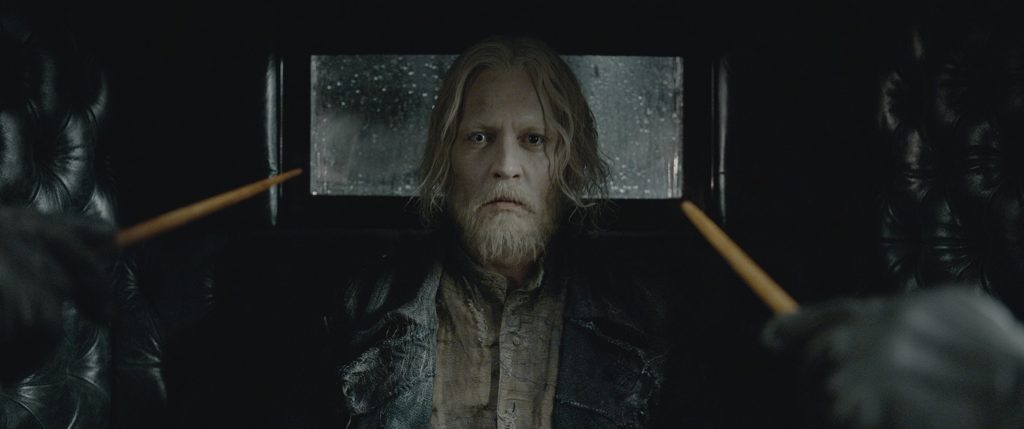
We have a French Ministry, or the Ministry of Magique, and there'[re] some lovely large dressing pieces, the multiple pieces and big officescapes. And so we’ve produced these ticker tape and ticker tape typewriters so that each desk has these wonderful keyboards, which are actually our interpretation of an original ticker tape keyboard. We’ve enlarged them and changed them slightly, but they’re basically a lovely idea. It’s almost like a crown. And if you remember, in the Ministry of Magic, the memos are paper planes that are flying around. Well, this one we’ve sort of played around and used a ticket [unintelligible] here, and the ticker tapes, they’re just like little snakes that are flying around [laughs] in the air, like swimming snakes. So that’s that idea.
There’s obviously going on this news case, which I I don’t know what to say about that. Really, it’s just… Yeah, these are from the previous [unintelligible]. I mean, it’s different. Obviously, we’ve got the hero prop on there. Or that was the effect ones.
Press: That’s the remote.
Pierre: Yeah, that’s the remote one. Sorry, I beg your pardon.
[Everyone laughs]
Pierre: Obviously, there'[re] prop ones and the effects ones like [La Salle?] said. There [were] stunt ones, rubberized ones. There’s a standard one there. This is an effects one, where in the previous film where Jacob goes into [the case] for the first time and they had a false floor and this wonderful rig that he jumps into and he gets stuck [in] because he’s quite chunky. And so we made this one that flicks him and he pops through the other side. Great bit of a performance with him. So yeah, a thousand ways of doing a case.
We have Newt’s menagerie this time, so we go into his basement where he’s got an animal hospital. And the [unintelligible] is a desk and everything, and then he has this little tree and he’s able to put Pickett into this, so he’s just [got] like his own little Bowtruckle tree and he’s able to go and rest and take it easy for a little bit and watch Newt do a bit of paperwork, so that was a lovely little thing to make. Same size leaves, but it’s not a bonsai tree, but it’s a cutting, although it looks like a bonsai tree.
There’s a character called Flamel. He has some [France?], and we built this for him. It’s a crystal ball, obviously. It’s just a beautiful piece to make, so glorious bit of design there. An object. I think you’ll recognize this, won’t you? I think this just… Hmm. It’s lovely seeing it. I mean, it’s funny seeing these because it’s one of the first things we ever made, was the Philosopher’s Stone. Yeah, to see that sort of come back in again and produce a stand. The stand is interesting. We’ve got something that looks so classic but that’s actually designed on a computer, and then we’ll use a RapidPROX type from technology and have it silver-plated.
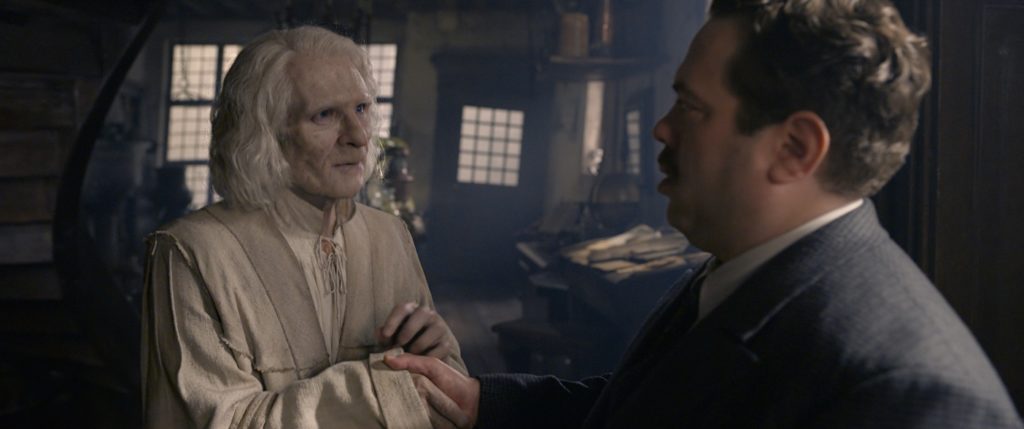
Press: [unintelligible]
Pierre: We do. We do. It’s a big influence on what we do. It opens it up, but it’s interesting because it’s such a popular method now, a very modern method, but for us, it’s about incorporation, so it’s really taking those processes. And we’ve been using it… I mean, at least we’ve been using it since Chamber of Secrets, so it’s not particularly new, but it’s about incorporation. It’s not like, “Oh, okay, from now on, we will do it this way.” It’s really empowering, the methods, and sort of liberating, the capacity of what we’re able to do, so it’s great. I mean, these two here, those singles off, they’re straight from the RapidPROX type machine. Very good CAD designers who understand form and size, etc., and that’s really how you work it, and then our wonderful, talented painters as well, the fantastic [Ruth?] and her team, just amazing. They make it convincing, really, so old skills and new skills. But you’ve got to understand what pieces and how pieces work and how they have to perform and actually have to work with in a film as well. I mean, for these archives for the Ministry of Magique, we had over 1,200 of these to make very quickly. And that allowed us to computer design the front, which was then machine tools were made very quickly, but the steel boxes were fabricated behind and things like that. So lots of different challenges. So there you go. I mean, this is just obviously a little taste of the elements we do, but there'[ve] been about 40 of us manufacturing things for about seven, eight months, so a lot has gone through the…
Press: Anything you rolled over from the first movie or started from scratch?
Pierre: Yeah, I mean, the majority is obviously starting from scratch. But there is stuff from the previous movie. This wand and obviously this wand, for one example, and then the few little elements, but it does move on. Interestingly, there'[re] two, three pieces from, actually, the Potter series, which was lovely to see some pieces we made on Chamber, and what else? There’s astronomy. It’s a very weird piece. It was in Dumbledore’s office. It’s three tiers of marble, almost like a miniature or like an architectural model. But they counter rotate and they’re covered in these beautiful pieces covered in… I’m not sure what it’s called. It’s all graphics, etc. So yeah, we got those two out. Yeah, so that was a… Oh, and a skeleton as well that hung from the ceiling from [the Defense Against the] Dark Arts [classroom], so yeah. Yeah, so all of those sort of things. So that was mine, so it was nice to blow the dust off and grab it out of the Tour, actually, and bring them back in and use them again, so yeah.
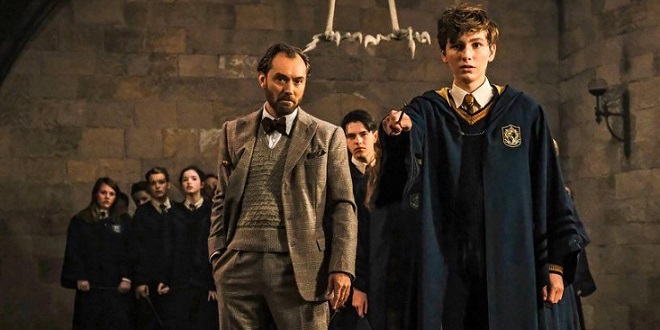
Press: The original Philosopher’s Stone? Because I was only told last week, but I thought I saw it there.
Pierre: Well, I have to say, there was more than one.
[Everyone laughs]
Pierre: First of all, when they originally filmed them, because of the nature of the light and because the translucent red is actually very difficult to light, it’s very reactive. So we ended up making a set of them, about five or six of them, [in] different densities of reds. All the same tone but just different strengths, because if it’s in the hand, it tends to get darker and it gets [a] very deep, deep blood red, whereas if you’re holding it up and the light’s going through, it can get very light. So it was just giving it different [shades of red] depending on how they were shooting it. So there was a whole range of them anyway as you go and you would do them, something like that. When we came to do them this time, we remolded and built again because [of] the distressing around this area here. And you can see, it’s actually been worn and you can… Now, when it gets handled, it gets worn, and really, the originals had lost their vibrancy, if that’s the best way to put it. So we had to refresh them. But it was all from the original shape.
Press: Can you tell us about the design of the new wands? You’ve got Theseus[‘s] and Flamel[‘s]. The Theseus wand is particularly beautiful. Could we see the Auror around them?
Pierre: Yeah, again, a reflection of the Auror is that… You’re right, and it’s that Theseus is… It’s a lovely wand. It’s that sort of marble handle, and it’s the wand of a confident person. It’s not complicated, but you can see it’s a mature kind of a powerful wand, really, I think. The perfect wand for an Auror. Again, it’s a nice, straightforward simple piece of design.
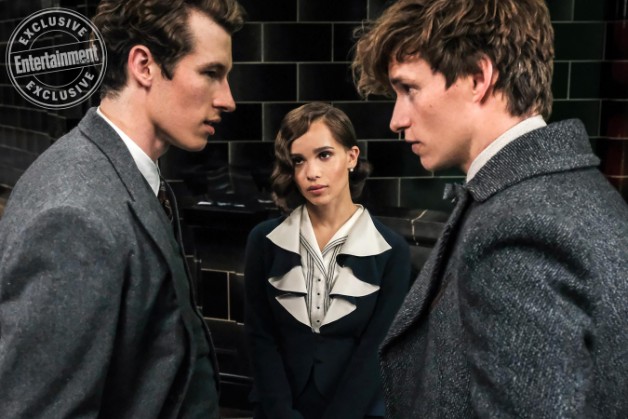
We have Flamel[‘s] here. Again, someone who’s obviously very old. Hmm. And got a very classic art feel. And obviously, there’s a horn section there, so something sort of quite individual. Nice.
The interesting thing with as far as wand designs [are] concerned is the application of a period as well. It’s a great period in time where in an artistic sense there is a lot of liberation and a sort of rethinking of styles, etc., and it really shows. Queenie’s is always lovely because I think it could only have come from one period, really. And I think it’s such a lovely deco piece. And so yeah, again, wands are really interesting for something that’s in the sense of things so straightforward but in a creative sense, can go down so many different channels. And so it can be reinterpreted a million times.
Press: Oh, I’m sorry. I was going to say, whose is the acorn, the wand?
Pierre: It’s Bunty’s. So yeah. Yeah, nice. Just a nice piece, isn’t it? Just a nice classic with an acorn and a leaf carved into the handles. Yeah.
[Everyone laughs]
Press: What was the thinking behind the Obscurus books? Do you know? I’ve seen it around a bit, but obviously, the Obscurus is a big part of the film, so why is the publisher called Obscurus?
Pierre: I have to put my hands up and say I don’t know. Yeah.
Press: The branded satchels… I don’t think we have them in the original Potter series.
Pierre: Well, no, because they’re periods. Well, no, remember, this is in the 1920s, so it’s a different time even then, isn’t it? So yeah. Isn’t it nice? Nice little touches.
Press: For Bunty’s, you would have [unintelligible].
Pierre: Well, let me think. I mean, so much of this stuff is that you don’t know the guys, and with everyone putting stuff together, you’re never 100% sure of what’s going to be seen and what’s going to not be, and we said that everything was going to be seen. But how it’s shown to [the] camera and how close you get and how it’s used, and so it’s just giving the filmmakers opportunities and richness to work with.
Press: Well, we went down to the docks early on with the luggage tags, which were attached to all the cases. I mean, surely, there’s no way a camera is going to see up close, but when you look at them, they’ve all got the name, the shipping line, and…
Pierre: Well, no, no. That’s exactly… It could be because David will turn up and will use the set and would… And gone are the days where a director would know where to put his camera. So you just give them the opportunity so they can do anything and can go anywhere. Yeah. There you go.
Press: What are some of the challenges of creating [the] French Ministry, British Ministry, just how you make those props different to reflect the different countries and sort of full…?
Pierre: Yeah, well, and again, the period is really interesting. I mean, yeah, it’s funny. When we started on the last film, [Fantastic Beasts and Where to Find Them], only till I read the script, I didn’t really get or understand or really come to the opinion how clever Jo was in choosing that time. Because it’s New York, mid-to-late-twenties. It was booming. It was the most confident brash, big, booming… All the films that are made, it’s a very recognizable period, even subliminally, the jazz period and all the gangsters and all that wonderful imagery that comes from it. So taking all of that and then throwing an eccentric, shy Englishman into the middle of that is just brilliant. It’s just fantastic. It mixes it up so well, and it’s so novel, really. Yeah, so I loved that. And then the nice thing about this film is that that carries on. France at that time was also [in] that Post-War boom and that enthusiasm, and especially in Paris, of the great… Well, before we come to the end of a great period of great creativity and great change with the Nouveau period and liberated thinking, etc., etc. So it’s just great. It’s a great revealing of early history and maybe stuff that we’re not as exposed to as we often are in a fantasy way, in a way that you can interpret and expand from it rather than purely being historical. So yeah, it’s great. I mean, we love it. We love it because you just say, “Right, okay.” Well, back to the wands. There’s an interpreting design from that time. It’s lovely.
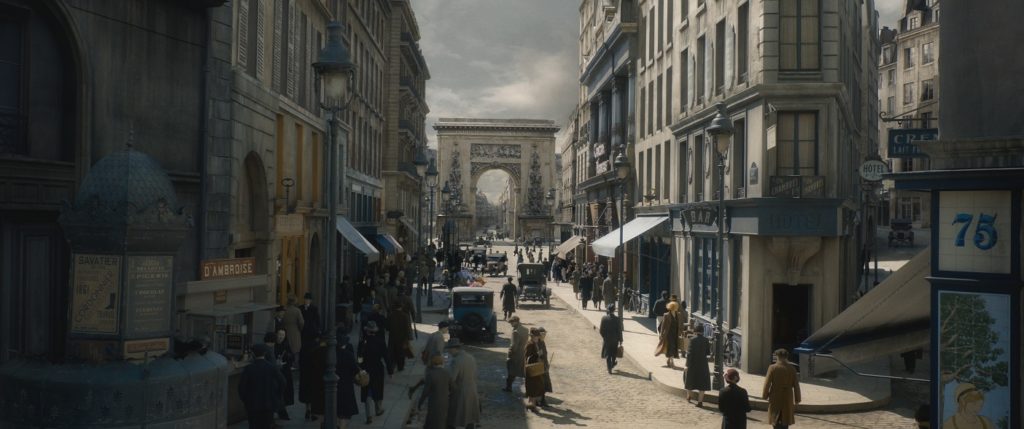
Press: Has there ever been a time on the set when someone’s acting something out and they just think, “I need a quill or something” and you guys have to run off and make whatever they think they need?
Pierre: Well, the gentleman behind you, he has that short stick all the time.
[Everyone laughs]
Pierre: Don’t you, Joseph? I mean, often, you’re standing behind [them] and those whimsical ideas will come for you. That’s why whenever your name comes up on the phone, it’s just like, “Oh, God. I don’t know whether I should answer this.” [laughs]
Joseph: We do whatever we can at the start of the film to get a mess, so just things that you can think of quickly. And quills and wallets and purses and glasses and… So you’ve always got a certain amount of stock of things to use.
Pierre: I mean, there’s a very big team, isn’t there? There’s the whole art department. That this is a big film with a big system and it all is to facilitate the shoot and people… I mean, obviously, there'[re] the physical aspects to doing what’s possible and what’s not. But everyone will try very hard to facilitate as much as they possibly can. And yeah, sometimes those things are “Could we do it in five minutes?” Sometimes it’s “Can you do it the next day?” Or “Can you do it next week?” And everyone will work very hard to try [to] give them what they want. But the trick is not to do it.
[Everyone laughs]
Pierre: That’s the ideal, yeah. [laughs]
Press: Last question. We hear one of the wands got broken. Theseus’s. Does that happen often, the wands often get…?
Pierre: It’s wear and tear and everything. I mean, everything gets very heavily used, so everything we make is always made in mind of actually the practical aspects of how it’s going to get used. But inevitably, things get used hard, and it’s only a matter of time [before] things break, so yeah. But especially with wands, I don’t like the idea of them breaking, and they’re spikes, basically, so it’s… But yeah, over the years, we’ve just developed materials and processes to try [to] make them as strong as they possibly can [be]. Yeah.
Press: And make as many as you can, I guess. [laughs]
Pierre: Yeah, I don’t know. I try [to] avoid making many. Good is better than numbers, but you’re right, some of the wear and tear. But I mean, he wouldn’t be using them as much as the action actors, really, so there’s always a standard set of six and probably more for Newt and people like that, so… And obviously for Daniel Radcliffe, who’s a famous fiddler who used to wear things out just by sitting.
[Everyone laughs]
Read the rest of our set visit coverage here.
This interview has been edited for clarity. Additional formatting provided by Felicia Grady.

